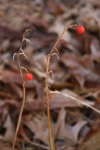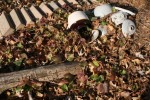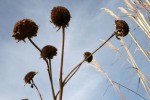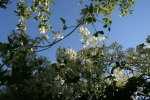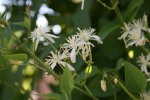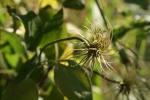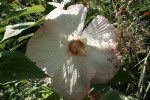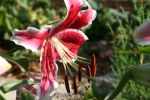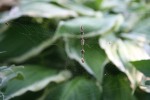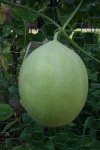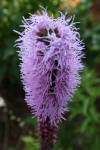Fairy Homes and Gaillardia Hopes
November 21, 2010
Thought I’d just take a stroll around yesterday and observe. Suffering from a cold, I wasn’t feeling up to putting away the windchimes or rolling up the hammock.
The hostas look like wilted lettuce left too long in the vegetable drawer, soggy and slimey. The lily of the valley leaves splay on the ground and their orange balls bounce above the mess. The speedwell is dry, like cinnamon sticks in the garden.
For a moment, I think that something has pulled apart a Damn Rabbit, as there is grey fuzz under my office window. I tense, looking for blood, and then realize this is the dirt out of my Dustbuster that I dumped the night before.
I feel sheepish.
The bellflower has done some seriously creeping on the berm this year; yes, it’s turning red, but in many places, it is still green and fresh. It seems to have covered a fairly large area this summer and it gives me another thing to look forward to next year. The garlic chives dry into castanets, their shiny seeds clattering in the wind, falling to the earth, to spread more garlic chive joy next year. Right now, the drying petals are delicate and transparent, amber colored and intricate.
And some of the flora are still growing. The alyssum is beautiful right now, healthy and sweet in the colder air. The sedum seems to be very confused, as there are fresh new petals emerging at ground level, underneath the yellowing stems and drying blooms. I tell them it’s not time, that they need to go back, but the oh-so-warm-for-November air has them at sixes and sevens and they can’t be stopped. The lamb’s ear is still sage green and fresh, the catmint actually reblooming.
I love catmint. It is the workhorse of the garden. One of the first up, one of the first to bloom, always coming back even after severe haircuts, staying at the party until the very last minute in autumn, trying so hard to hold onto summer fragrance, summer bloom – summer.
The prairie dropseed looks like fireworks, golden bursts on a deep green sky. More and more milkweed pods split each day – our friends the milkweed bugs have hosted their last orgy. The satin sheets and scented candles are stored away now until next year and they will drowse in hibernation, memories of those Bacchanal days drifting through their dreams, giving them impetus to survive until the spring.
The feathers on these seeds are just that – like feathers. They are soft as silk, like Griffey’s fur when he is cleaned and combed, like a stroke of a Damn Rabbit. I rub one between my fingers and it comes loose and floats away, the sun winking on the white feathers, flashes of silver and gold.
Some of the coneflower heads have been chewed open, exposing a teeny tiny hole in the raised seed head. What a great place to build a house! I can imagine a miniscule fairy, sprinkling twinkling dust along the outside, giving the pod a rehab before the move-in. What a cozy place, the fairy thinks. Just the right size door to pull my wings in after but keep the wind, rain and snow out. The round room inside is a perfect place to put up my feet, or roll into a ball, thinks this most indolent fairy. And what good fortune! Several of these space all together! I can use one as a bedroom, one as a store room for seeds to eat through the winter – I’ll be as snug as a bug in a rug.
While these fancies take me over, I notice the gaillardia seed heads are in the same phase – drying and falling apart.
I have promised myself I’m only observing. I don’t want to aggravate this cold.
I grab a bucket and start cutting heads – nearly dry, really dry and everything inbetween. There are dozens and dozens, more than I thought on initial glance. They fall into the bucket with small dull thuds. I gather quite a bunch, then head to the front, to the bed with the Siberian iris and the new butterfly bush. I stand back and look at the bed, at the empty spots between the iris, next to the peonies and around the butterfly bush. I see in my mind’s eye the contrast of the white peonies with the purple iris, then as that fades, the purple chaos of the butterfly bush complemented by the unbridled havoc of the gaillardia. Oh, how sweet!
I indicate eight spots where a gaillardia should emerge and then begin digging. I hit no bulbs in the first hole and throw in a handful of seed heads. The same goes with the other seven holes, a first in autumn planting.
This is just a hope and a garden prayer. I’ve done this with coneflowers and reaped fantastic results, but I don’t know if the same will be true of gaillardia. I’m hoping that since it’s a prairie plant, since the seed heads dry, droop and decay, it will be the same. I’m hoping that the squirrels don’t dig them up, that mice don’t find them, that they don’t freeze beyond hope of germination in the ground this winter. I’m hoping that they sprout in the spring, that they grow and that they bloom.
I’m hoping.
- lily of the valley
- hostas wilting
- speedwell dried blossoms
- spotted bellflower creeping over the berm – watch for the leap next year
- hostas in the sun
- prairie dropseed fireworks show
- purple liatris
- milkweed seeds
- horsefly sunbathing
- peonies and the growthrough grid
- peony leaves
- sunflowers and pampas
- the storage bin?
- proper home for a fairy
Sunshine Kisses and Tiny Visitors
September 17, 2010
A beautiful, sunny, gorgeous summer day, with hints of fall all around me. When I walked around the corner of the house, I literally ran into a wall of fragrance from the sweet autumn clematis. It was shocking, astonishing and delightful, an invisible surprise that made me react physically. It is already getting past its prime; the honey is now tinged with a bite of cinnamon. (Makes me want toast.) The middle of the blossoms pucker up, like lips ready to kiss the sunshine.
There are fewer and fewer milkweed bugs, no babies anywhere to be seen. I’m learning that they have a natural antifreeze in their bodies to help them hibernate through the winter months, so we’ll see them again next summer, happy, healthy and frequently copulating.
Spider webs everywhere again – big ones in the veggie garden and on window sills, medium size webs between the bricks and between drying stems, teeny tiny two- and three-threaded webs between seeds on drying blooms. A huge bonus today for watching and observing; a miniscule red spider, so small that I wouldn’t have noticed it had I not been making multiple exposures of the same clematis seed head. She ran up and down each prong, starting at the bottom and continuing all the way around, like a Spirograph. She was smaller than the head of a pin, about the size of a pencil dot. How amazing that she is mostly unseen, unnoticed, but places a role in the garden, even if it’s just randomly running around a clematis seed head.
The ajuga is wilting like spinach in a hot pan, getting ready to disappear for the winter. There are hundreds of acorns scattered throughout the beds, and more ticking to the ground every day. They crunch underfoot on the bridge and drop into the pond, drawing the goldfish.
A Dion Skipper lands on a foxglove leaf and poses for a photograph. The leaves on the trees in the parkway yellow and fall, the honey locust sheds and the lily of the valley forms the orange fruit which is very poisonous. I’m thinking to plant some on the berm later this fall; it is happy in the shade and under the pin oak we certainly have shade. The weglia on top of the berm is very much in need of a good trim and shaping. I wanted it to get established before I whacked at it, but it certainly needs a whack now. It in branchy and thin, pointing every which way with no shape or attractive form.
The beans are happily growing and the spinach is thriving. No sign of the lettuce. I’m thinking we’ll have some fried green tomatoes this weekend.
- wasp on garlic chive
- lily of the valley fruit
- clematis from below
- clematis kisses
- tiny red bug on top of clematis seed head – see her?
- from the berm
- the berm from the berm
- untamed weglia
- dion skipper posing
- spiderweb in the lamb’s ear
- green tomatoes
- clematis on the front of the house
- spiderweb between stems
Deceitful Vegetables
July 14, 2010
This morning, I watched a robin splash in the pond and then perch on the fence to groom herself. It was like watching Eliza get ready for the day.
The robin sat down ruffled, fluffed, feathers all askew – a real mess. Then she dried herself off by moving her wings and tail in a way that’s almost impossible to describe. It certainly wasn’t flapping. It was more like a vibration, but not really. Kind of like twitching, but much faster and more vigorous. Flutter is too gentle, because it was really a powerful movement. I think agitate comes close; quiver is much too timid.
I digress!
After she was dry, she preened and smoothed her feathers and arranged her wings and stroked that red breast until she was pretty as a picture. And then, much to my surprise, she dove right back into the pond.
Yesterday, the stargazer lilies that we purchased at the Chicago Flower show burst into bloom. They are deep pink, a lipstick kind of color, and have the strangest little splinters of pink growing from the sepals. The stamens dangle like earrings and bob and dance. Tony looked at them and said “We did good.” They are stunning; bright, majestic and real show pieces in the garden. They face my office window, so I am enjoying them all day.
The hibiscus is blooming too. Big dinner-plate size flowers, almost white but with a blush, a hint, a touch of the palest pink. They are thin like tissue paper and flap in the breeze. The dianthus I transplanted is still not happy in its new spot, but it didn’t like the old spot either. The new ones in front aren’t blooming either – I think this is a “wait until next year” situation.
The lily of the valley are setting big fat seeds, green and round and earthy. I found a spider’s web between hosta stalks and saw her path of destruction – a line of sedated and webbed insects that she’ll eat at her leisure. I thought of Bilbo Baggins and his friends all bobbing in a line, captured by the giant Spider. We need a Sting here – or do we? Isn’t she entitled to eat too? And if those are all mosquitos in her web, I’m good with that.
The liatris gets more mop-headed by the day and the coneflowers just keep blooming. The grasses cannot be appreciated or understood in photographs. The pampas grass is sharp and seems to fountain out of the ground. It rustles and whispers and rattles – covered with tiny sharp hairs. It is an experience of sight and sound and touch – it cannot be captured in a photograph.
But I tried anyway.
There was a Red Admiral butterfly in the garden that I believe was auditioning for a modeling career. For 26 photographs, it stayed on the same small group of flowers, gently opening and closing its wings, turning to different angles, seeming to pose for me in all different positions. When I finally reached saturation point and moved on to the milkweed, it actually followed me, like it was still eager to be photographed. Either that or my hair smelled good.
If you stand under the arbor now, you can smell honey.
The monardia (bee balm) continues to bloom, making the transplanting transition successfully. The phlox has lost its mojo. The watermelon grows and more form along the vine every day now – I can see them and notice them. Dominic finally noticed the panty hose and was confused.
The purple runner beans are ready for harvest, so we had a batch last night. I was really geeked about them, as I picked the biggest and nicest purple beans and put them in a pot with regular green beans, thinking of how pretty that mix of greenn and purple would look on our dinner plates. Put water in the pot, put the lid on and lit the stove. Minutes later, when I drained them into a colander, I was so so so disappointed. All the purple had simmered out of the beans, leaving them just as green as the regular beans. And I’m finding there is no way to mitigate this unless we eat them raw.
I am so disappointed. I feel betrayed by these beans, all the anticipation for naught, all the careful watching useless. Those beans lied to me.
- Stargazer lily
- hibiscus
- unhappy dianthus
- lily of the valley (and Jeff Goldblum)
- stargazer with those dangling stamen – like earrings on very skinny ears
- spider’s web
- watermelon
- liatris
- Our model butterfly
- Look at the “hair” texture of the wings – isn’t that neat?
- bee balm
- pampas grass – you must see it to appreciate it
WHERE are her parenting skills?
May 4, 2010
So my undies are in a total wad about these babies now. I worked in my office all day yesterday and she never showed up. I checked the nest this morning and there was a dry leaf on top of it. This late afternoon, the leaf is still in the same position. When do these babies EAT? And WHY do I care?
I’ll tell you why – because I do not want to have to pick up their poor dead skeletons, that’s why! And now my maternal instincts have kicked in. I was up checking on them in the middle of the night – good grief! I just want to see the mom and tell her straight up that while it may take a village to raise a child, I’m not the mayor!
I moved the leaf (with gloves) and see that more dead grass has been piled over the nest. So she must have shown up at some point to either a) tend them or b) throw some cover over the whole mess and go tramping again. I’ll check them again later this evening. Poor little things…
Meanwhile, the clematis have exploded in a glory of purple, the allium are bursting into starry globes and the lily of the valley is so prolific, you can stand in the yard and get high on the perfume. With the surge of growth, I have lamb’s ear and oregano to spare and was fortunate enough to give some to my friend Andrea this morning. She of the Black Thumb is going to put them in and see if they flourish. She claims she kills silk.
The lamb’s ear is originally from a friend of my parents, Frank. Frank passed away about 12 years ago, way too young and way too fast, from cancer. Frank gave lamb’s ear to my mom, my mom gave it to me. I gave it back to my mom when she moved and then she gave it back to me when I moved. It’s planted in friend’s gardens all around my neighborhood now. Frank lives on in all these gardens, I think. Isn’t it nice to think you can achieve immortality through a garden?
If Andrea kills them, I will really believe she has a Black Thumb.
- The bunny nest – where is mama?
- Coral bells ready to bloom
- The butterfly garden
- Allium in bloom
- clematis in bloom
- Clematis in a wider shot
- from the entrance to our garden
